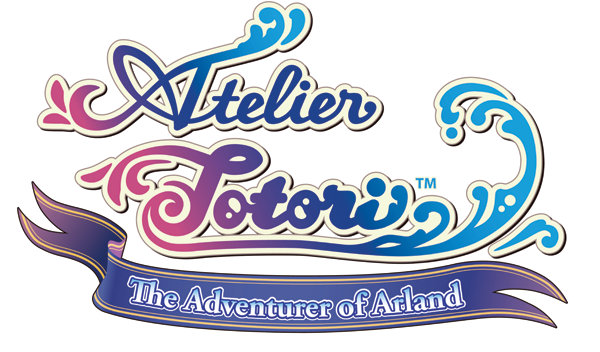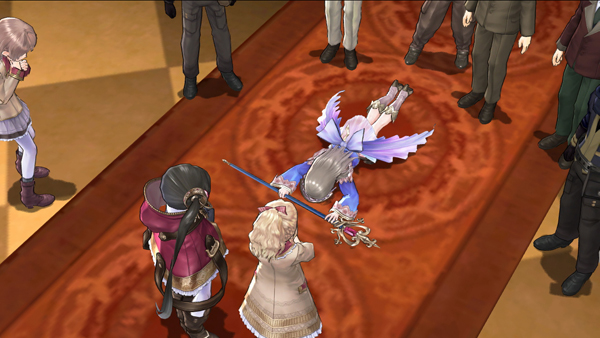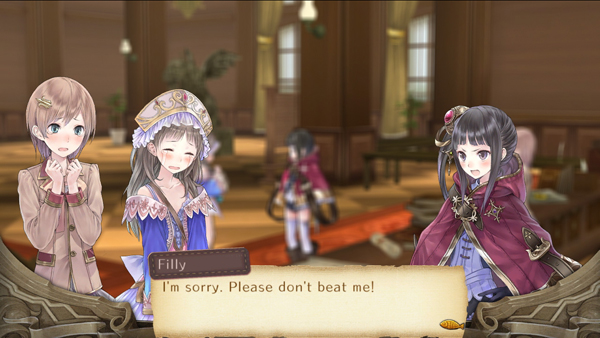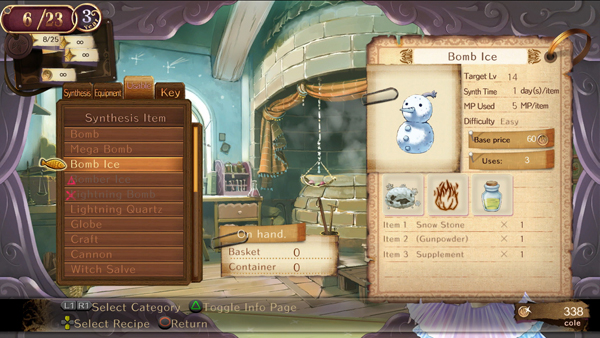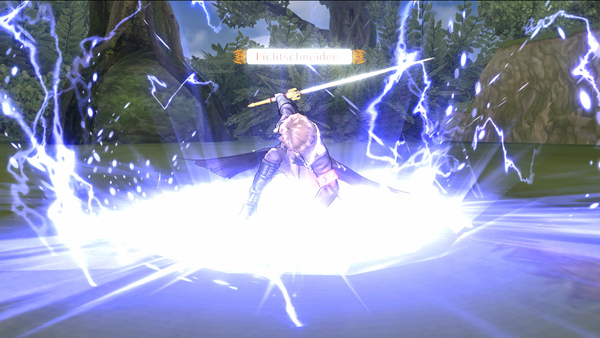Gust and NIS America are determined to synthesize something spellbinding with Atelier Totori: The Adventurer of Arland.
Preceded and succeeded by her triple-tapped sisters, Rorona and Meruru respectively, Totori is the middle child in the Arland series of Atelier games and the star of this title. Consider Arland a sub-world within the Atelier label —Salburg and Gramnad numbering its companions — which stands as a universe on its own while maintaining the general Atelier façade of synthesis, adventure and character.
In keeping with continuity, Totori was taught by the clumsy Rorona, a trait reflected in the student’s initial approach to alchemy. Within her chapter, the protagonist of falcated filigree sets forth from her seaside home to renounce the mundane existence its lazy shores promise. Because the mundane does not often make for a good video game. Arrested by a yearning to locate her lost mother and what can conceivably be interpreted as either wanderlust or an aversion to authority, Totori begins the arduous journey to become a top tier adventurer.
That seemingly terse description is, in truth, the plot. Atelier games are not known for their emotionally puissant or conceptually volute narrative. Gust reconciles this with an attention to the inner workings. Consider the story an otherwise ragged sundress brought to beauty by the brilliance beneath.
In contrast, the wonderfully woven cast does well to fulfill their charge and marshal an atmosphere both lively and exhilarating. Totori is, at her confectionery-fueled core, an entertaining milquetoast. The lass’ powerlessness versus others serves as the prime capacitor for scenes both chortle and baw-worthy. Her inimitable charm will find the contours of your barren soul, extract it from the many-warded phylactery, and meekly explain how she would very much like you to stop being such a virulent little bitch. Likewise, her cohorts share a penchant for drawing you in. Returning characters like Rorona will please series veterans with a return to strange while new arrivals populate a Watership warren of varied but endearing personalities. You’ll be energetically joined by a not-quite-mad-but-just-a-slight-slanted scientist, engage with perverts — just like real life — and be reminded just how invisible your father has become. Because you’ll never live up to his expectations. For completionists and those interested in forging relationships, the most prominent characters have all been afforded their own endings.
It’s worth nothing that NIS America has done a commendable job in bringing their mannerisms to the English language. Good localization preserves an idea, a mood, and makes it valid in a foreign tongue and culture. That’s what separates localization from translation, and that’s why playing Atelier Totori in English feels like you’re playing it in its source language.
One cannot approach an Atelier game without familiarizing themselves with its array of alembics, retorts and calcination devices. Alchemy is the series’ fundamental mechanism, established on synthesizing unlikely ingredients to yield unlikely products. Sure, many conventional concoctions make sense: the constituents of a Medicine Base are various organic items; Silkis uses spider web and liquid. Then there are the more eccentric creations: tuna bombs or a gel-covered parasol.
Alchemy follows a simple concept: meet the ingredient requirements and the output is reliable, save errant failures. You needn’t venture deeper, but the option is there. Items carry traits that can affect the quality and characteristics of the final product, leaving plenty of room for the player to experiment with equipment effects and item augmentation. Really, it’s a robust system built upon basic principles that ends up being both accessible and deep.
There are times when an enterprising adventurer must forsake the scent of sulfur and oxides to brook the beasty types of neighboring ruins and hazardous dens. Typically, one can best noxious foes with an awkward strike from Totori’s bauble-embellished staff. These encounters are often with sedated barrel-wielding squirrels or prismatic flan. Press beyond the beaten path, however, and you may find yourself staring into the cavernous maw of defeat. At which point you will either learn to avoid these chiefly optional encounters or court the comely system of item traits to cull the most from your trappings.
Now that it’s clear just how pernicious gathering materials outside the atelier can be, a question of the skirmishes themselves must be raised. After all, you aren’t going to parlay a monster to death. When faced with battle, you’re faced with simplicity. Each character boasts a massive two active skills and a number of passive abilities. Totori is a frail creature, so her companions can also deplete a regenerating gauge to throw themselves in front of an attack with all the gusto and chivalry of a deceased knight in shining armor or, alternatively, provide back-up to her offense. Of course, if that all seems rather base, it is. The juggling of assist abilities(when to use them and when to let Totori suffer a grievously amusing pan to the face), exploitation of synthesized dynamite used by the titular character and attuning oneself to a boss’ clockwork can be challenging. Not quite as challenging as Atelier Iris’ three golden pigs, but a challenge nonetheless.
Even more aggrieving than a pouty protagonist is the game’s most draconian approach to time management. Want to go for a walk? Craft a potion? Quaff a potion? Take a nap? Battle? Gather ingredients? Well, that’s going to take time, sucker. All of it. While Totori stands in every other element the ultimate sequel, its approach to strong-arming the player into working toward a goal is now even less forgivable than in Rorona. You’re given a period of years to renew your adventurer’s license and finish the main quest. Unfortunately, those years dwindle at a bewildering pace. Travelling can take months, everything else, days to weeks. And that is the greatest carp one can raise against Atelier Totori. The imposed pace turns what could have been a leisurely romp into an oppressive ordeal. Urges to explore or needlessly experiment now must be weighed against the larger cause and, more often than not, sloughed as ineffective uses of valuable time by the temporal arbiter. He’s a merciless bastard.
That bothersome fault was thrown mid-composition to dampen the blow to what remains a truly captivating experience. Fostering friendship with your comrades and the pursuant interactions are rewarding. Skits appear throughout the story, unpredictably, with vigor and the intention of leaving the player ensorcelled.
One particular mechanism that fits nowhere else but deserves mention is the license. In order to advance as an adventurer, thus obtaining permission for license renewal, you must accumulate license points. This is addressed as a function very much like achievements. Discovering new domains, completing quests, slaughtering certain foes, synthesizing and a variety of random triggers all net points toward your goal of ranking up. It’s a neat addition which encourages the player to explore and experiment.
Atelier Totori is Gust’s third excursion into the world of the third-dimension. By now, they’ve become artisans in the way of bringing what has always been a visually-inviting two-dimensional world to the third. Arland takes shape in gorgeous storybook form, brightened with chromatic splendor and made worthy of a current-generation endeavor. The luminous palettes enliven even the most foolhardy of static designs. And, given the most attention, diminutive Totori surely benefits.
Often, and to Totori’s mousy objection, I would curtail gathering flora to ever-so-slightly nudge the left analog stick. She would begin her slow gait and I — a once intransigent champion of 2D — would appreciate her butterfly-tailed craftsmanship. From the delightfully goofy success kid pictured below to the intense countenance of the girl searching the bottom of her oversized bag for a meteor while that mischievous tongue reaches for a dimple, Gust has sculpted something representative of a series’ graphical progression. Eye-parts will curse, swoon, and convey hushed envy.
Everything is tied together with acoustic sedative. Something cosseting which politely frames the moment and hearkens to the days of aged Atelier games. Gust’s sound team sunk marginally in the prior Atelier entry, but it’s clear that Totori has brought with her a revitalization of the exceptional crew. “Pilgrimage”, the opening theme, does well to bring about the setting reinforced by similarly pleasing tunes like “The Waves Call My Name” and the battle beat, “Yellow Zone”.
Ultimately, Atelier Totori: The Adventurer of Arland should enthrall fans as a polished, progressive iteration in the long-running series. Newcomers who fancy item creation, animated dialogue and, of course, adventure, will want to synthesize just one more brew.
Give Totori a chance and you may find it hard to leave.
Platform: Playstation 3
Developer: Gust/NIS America
Genre: Role-Playing Game
Time: 20-30 hours for the main quest. Multiple endings can increase that to 30-80 hours.
Gripes: Why can’t I just relax? Everything takes time, and you aren’t given much of it.
Get it for the: Cheeky conversation, alchemy system and lovely aesthetic.
Full Disclosure: PXOD received a review copy of the game.

